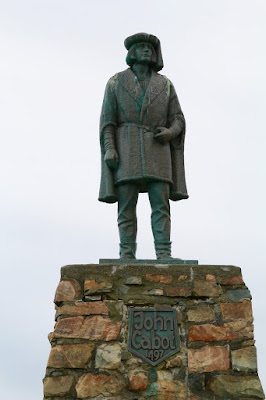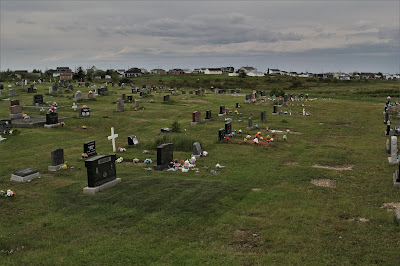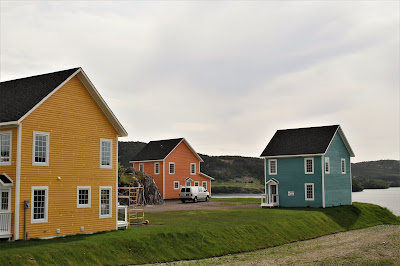We got an early start so we could head to Bonavista to see the its lighthouse and other sites. On the road, we saw some lovely vistas, some we stopped to photograph, some we took while moving.
(click on an image to be taken to a larger view)
We saw this beautiful church in King's Cove and we had to stop to photograph it.
lighthouse in the far distance
above is a loon in the water
As we entered the town of Bonavista, we could see a new pier was being built. It is really quite interesting to see the process of building one.
We stopped in one parking lot before we drove through the town of Bonavista on our way to the lighthouse.
Here are some photos I took while we were driving through Bonavista.
When we arrived at the Bonavista Lighthouse, the skies were threatening. You could see there was a storm off in the distance heading our way. We found a place to park below the lighthouse and walked out to an observation area. Down on the jagged rocks, if you look carefully, you can see some Cepphus. These are medium-sized birds from the Auk family that are mainly black in the breeding season with thin dark bills and red legs and feet. Two of the species have white wing patches, the third has white facial “spectacles”. They are much paler in winter.
John's vivid photos
We had to quickly leave the outcropping and head back to the RV as big, fat rain drops started pelting us, and as the weather was quite cool, it was not something you wanted to spend much time in or you would be drenched and frozen in minutes.
Once the rain slowed down, we made our way up to the lighthouse. A bus tour was just arriving, so we decided not to wait in line for a tour of this particular lighthouse. The lighthouse at Cape Bonavista was built between 1841 and 1843 to mark the entrances to Bonavista and Trinity bays and to aid mariners headed for Labrador. It is the fourth-oldest lighthouse in Newfoundland. The two-story wooden building is constructed around a masonry tower surmounted by a lantern.
Over to the right of the lighthouse was an area where you could walk and see puffins. This would be our first view of these amazing birds today, but not a very close view.
Those are puffins on those rocks.
Holy moly! Look at those puffins fly!
As you leave the Bonavista Lighthouse, a statue of the famous explorer, John Cabot adorns the harbor side. John Cabot was a famous explorer who landed either at Cape Bonavista in June of 1497, the exact location is unknown. The government recognizes Cape Bonavista as his official landing spot where he came ashore and claimed the "new found land" for queen and country
we found a statue of John Cabot and the landing area were he first came ashore and declared he had claimed "new found lands" in the of his queen and country. We also saw our first puffins at the lighthouse. The next expedition in 1498 which John Cabot took after his return trip from Cape Bonavista, was his last. John Cabot and his crew were in distress at sea and were never found again.
We returned to Bonavista because I wanted to find where The Matthew was docked. I used to take my students to Plimouth Plantation and on a tour of the Mayflower II, and I was very interested in seeing and possibly touring The Matthew or at least I wanted to be able to take a picture of it, but try as we might, we could not find it anywhere. Either they have it hidden away somewhere so you have to pay to see it and tour it or it is off site for restoration like the Mayflower II is at home. I was a bit disappointed by this.
On our way out of town, I continued to take photos of the adorable houses as we drove.
We continued on our way to Elliston to see if the stories of that being the place were you get the best and closest views of puffins was true. We made a short stop at the Visitors Center where we saw the Sealing Memorial. It was quite a moving memorial. On March 30, 1914, 132 men left the SS Newfoundland to hunt seals and became caught in a sudden blizzard while out on the ice. Only 55 survived. During the same storm, the SS Southern Cross sank while returning to Newfoundland from the Gulf of St. Lawrence. All 173 men died.
We found Elliston and the Puffin Viewing Site. The site is free to the public, but they do accept donations, and after spending quite a long while there, we each left them a donation. It is a 5-10 minute walk in over uneven ground.
If they are not careful, the path will erode away soon and no one will be able to walk out to see the puffins.
When we approached the area, there were about 5 people already sitting down and at least a dozen puffins milling around on the edges of the cliff. We slowed down and continued our approach slowly as to not startle the puffins away. We then were able to enjoy the show they were putting on. After a time, the puffins all flew away, new people walked in and were coming too close to the edge for the puffins to feel comfortable to return.
Here's a video I took at Elliston of the puffins.
We continued to sit and wait.
mom's dragonfly





































































































































No comments:
Post a Comment